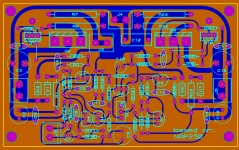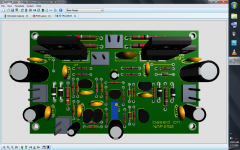Hi, I'm not if anyone here has experience of these Avondale (UK) amplifier modules that can offer some help.
I would like to change the orange tantalum input capacitor to a polypropylene film cap of a different value to alter the 'sound' of the module. I find the module a little bright in my system and someone suggested that altering this cap to a slightly higher value from 10uf to around 15uf would take the brightness a little?
Can anyone offer any insight as to whether this is likely to happen and will I need to alter any other components to compensate this change??
Many thanks.
I would like to change the orange tantalum input capacitor to a polypropylene film cap of a different value to alter the 'sound' of the module. I find the module a little bright in my system and someone suggested that altering this cap to a slightly higher value from 10uf to around 15uf would take the brightness a little?
Can anyone offer any insight as to whether this is likely to happen and will I need to alter any other components to compensate this change??
Many thanks.
I think this is a question of personal taste in your audio system, speakers and room or perhaps the details of the build, rather than a technical issue with the module. You may find more impressions on the sound quality of NCC200 and other Naim clones here: Avondale NCC220 + Minicap6 monoblocks | pink fish media I refer to that particular post because of the author's recent and interesting comments on sound quality of the NC200 modules he retrofitted to a Naim NAP110 - a near direct substitution. There are many other threads and comments on the modules that you can search there in the DIY section of PFM forums. I know that Avondale's Les Wolstenholme posted there as recently as October, so you may get some input from the designer if you post there.
As general comments on input caps, large ones (particularly PP film caps) are susceptible to EMR from power supplies etc. and this can be troublesome unless there is sufficient distance or shielding from the power supply, switches and supply wiring - even RF from external sources, tuners SMPS etc. This isn't always possible with some layouts so I've had to wrap earthed copper foil around large caps and even restore some retrofits that proved to sound worse (harsh) rather than better with film caps that should otherwise have performed better at HF. To check whether the input cap has problems, I often parallel a smaller film cap such as 100nF with it before wasting money, as good quality film/foil caps such as Auricap, Sonicap etc. aren't cheap.
Increasing the cap size to 15uF is unlikely to help - the value is already much larger than necessary and is likely to exacerbate problems. I have seen Naim clones with even 47uF fitted there but I think that has more to do with inventory costs than sound quality. If you want to experiment with larger values, try quality electrolytics in a small size first, such as Panasonic's popular FC or FM grades (watch the polarity) which you can obtain from most distributors.
As general comments on input caps, large ones (particularly PP film caps) are susceptible to EMR from power supplies etc. and this can be troublesome unless there is sufficient distance or shielding from the power supply, switches and supply wiring - even RF from external sources, tuners SMPS etc. This isn't always possible with some layouts so I've had to wrap earthed copper foil around large caps and even restore some retrofits that proved to sound worse (harsh) rather than better with film caps that should otherwise have performed better at HF. To check whether the input cap has problems, I often parallel a smaller film cap such as 100nF with it before wasting money, as good quality film/foil caps such as Auricap, Sonicap etc. aren't cheap.
Increasing the cap size to 15uF is unlikely to help - the value is already much larger than necessary and is likely to exacerbate problems. I have seen Naim clones with even 47uF fitted there but I think that has more to do with inventory costs than sound quality. If you want to experiment with larger values, try quality electrolytics in a small size first, such as Panasonic's popular FC or FM grades (watch the polarity) which you can obtain from most distributors.
The NCC200 by Avondale are based on NAIM right? I am also doing a version based on NCC200 which were based on NAIM, so my work is also a NAIM copy (not a clone I guess). I'm doing my own pcb lay-out, it is single sided and trace routing is mostly done by electra with a few re-routing done by me to shorten some traces. Don't mind the copper zone the program wanted me to label reference points for the zone. By default it was laid as ground plane...anyway I hope I am allowed to show my work here.
Albert
Albert
Attachments
- Status
- Not open for further replies.

